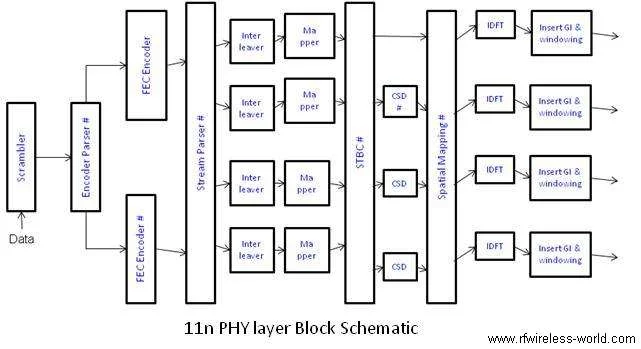802.11n Physical Layer
11n Introduction
This part of WLAN tutorial covers following:
What is wlan? WLAN standards-11a,11b,11g,11n,11ac 11a WLAN Physical layer 11b WLAN Physical layer 11n WLAN Physical layer WLAN 802.11-ac WLAN 802.11-ad WLAN MAC layer Difference between 11a,11b,11g,11n WLAN router providers WLAN providers
This paper on 11n physical layer describes WLAN-802.11n wireless networking standard, introduced by IEEE. It covers various frames transmitted by 11n compliant device and 11n physical layer.
It is the successor to previous standards i.e. 802.11a and 802.11g. It supports the features supported by these legacy standards. The main idea for 11n is to increase the data rate. This done by increasing the Bandwidth to 40 MHz from legacy systems of 20 MHz and supporting multiple streams. Maximum 4 streams are supported by the standard.
11n Frame Structure
In 802.11n system, WLAN OFDM system supports three physical layer models. They are Legacy mode, Mixed Mode and Green Field Mode. In legacy mode bandwidth supported is 20MHz and 64 point IFFT is used. It supports legacy 11a and 11g systems. L-SIG is as per SIGNAL field structure defined in the IEEE 802.11a standard. HT mode is supported in both green field and mixed modes. 40MHz bandwidth and 128 point IFFT is employed here. HT-SIG field is described in IEEE 802.11n-2009 standard.
Legacy Mode
In the legacy mode, frames are transmitted in the legacy IEEE 802.11a or 11g OFDM format.
Legacy Frame= L-STF(2 sym) + L-LTF(2 sym) + L-SIG(1 sym, 4 microsec)+ Data symbols
Mixed Mode
In the Mixed Mode, frame is composed of both legacy preambles/header as well as 11n compatible preambles/ header (HT) as shown below. This is done so that such frame is decoded by legacy 11a/g devices.
Mixed Mode Frame= L-STF(2 sym) + L-LTF(2 sym) + L-SIG(1 sym, 4 microsec)+HT-SIG(2 sym) +HT-STF( 1 sym) +HT-LTFs(4 microsec per LTF) + Data symbols
Green Field Mode
In the Green Field mode, legacy preamble, HT preamble and Header are incorporated as shown below.
Green field Frame= L-STF(2 sym) + HT-LTF1(2 sym)+HT-SIG(1 sym)+HT LTFs(4 microsec per LTF) + Data symbols
802.11n Physical Layer
802.11n physical layer Transmitter The transmitter is composed of Scrambler,Encoder parser,FEC encoder,Stream parser,Interleaver, Constellation mapper,Space time block encoder,Spatial mapper,IDFT, Cyclic shift insertion,Guard insertion,Windowing and packet formation.

Scrambler
The scrambler scrambles the data to prevent long sequences of zeros or ones. For more information refer standard section 20.3.10.2
Encoder parser
Encoder parser de-multiplexes the scrambled bits among NES (number of FEC encoders) FEC encoders, in a round robin manner.
FEC encoder
FEC encoder encodes the data to enable error correction-an FEC encoder may include a binary convolution encoder followed by a puncturing device, or an LDPC encoder.
Stream parser
Stream parser divides the outputs of the encoders into blocks that are sent to different interleaver and mapping devices. Bits to the input of these interleavers are called as spatial streams.
Interleaver
If BCC encoding is to be used, the interleaver interleaves the bits of each spatial stream (changes order of bits) to prevent long sequences of adjacent noisy bits from entering the BCC decoder.
Constellation mapper
Constellation mapper maps the sequence of bits in each spatial stream to constellation points (complex numbers).
Space time block encoder
constellation points from Nss spatial streams are spread into Nsts (space time streams) using a space time block code, whereby Nss less than Nsts. Refer section 20.3.10.8.1 Space Time Block Coding-STBC.
Spatial mapper
The spacial mapper maps space time streams to transmit chains. This may include one of the following:
• Direct mapping: constellation points from each space time stream are mapped directly onto the transmit chains (one-to-one mapping).
• Spatial expansion: constellation points multiplied by matrix will expand the points to produce the input for all the transmit chains.
• Beam forming: It is similar to spatial expansion, where vector of constellation points from all the space time streams are multiplied by a matrix of
steering vectors.
IDFT
Inverse discrete Fourier transform (IDFT): converts a block of constellation points to a time domain block.
Cyclic shift (CSD) insertion
CSD insertion of the cyclic shifts prevents unintentional beam forming. There are three cyclic shift types as follows:
• A cyclic shift specified per transmitter chain with the values defined in Table n61 (Cyclic shift for non-HT portion of the packet) (possible implementation is shown in Figure n63 (Transmitter block diagram for the non-HT portion and the HT signal field of the HT mixed format packet )).
• A cyclic shift specified per space time stream with the values defined in Table n62 (Cyclic shift values of HT portion of the packet) (possible implementation is shown in Figure n64 (Transmitter block diagram for the green field format packet and HT portion of the mixed format packet except HT signal field)).
• A cyclic shift Mcsd (K) may be applied as a part of the spatial mapper, see 20.3.10.10.1 (Spatial mapping). When beam forming is not used it is sometimes possible to implement the cyclic shifts in the time domain.
Guard interval insertion
The guard insertion module
extracts last few samples of the OFDM symbol and appends at the beginning.
Windowing
Windowing smoothes the edges of each symbol to increase spectral decay.
Packet formation
packet is formed as per the frame structure defined in the section above.
REFERENCES:
IEEE 802.11n-2009 Standard
WLAN RELATED LINKS
802.11ad basics
what is wlan?
11a PHY
11b PHY
11n PHY
WLAN 11-ac
Difference between 11a,11b,11g,11n
